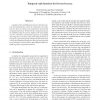757 search results - page 89 / 152 » How secure are secure interdomain routing protocols |
TIFS
2011
13 years 2 months ago
2011
— “Pairing” is the establishment of authenticated key agreement between two devices over a wireless channel. Such devices are ad hoc in nature as they lack any common preshar...
SCN
2008
Springer
13 years 7 months ago
2008
Springer
Consider an electronic election scheme implemented using a mix-net; a large number of voters submit their votes and then a smaller number of servers compute the result. The mix-net...
CSFW
2005
IEEE
14 years 1 months ago
2005
IEEE
A number of key establishment protocols claim the property of forward secrecy, where the compromise of a longterm key does not result in the compromise of previously computed sess...
CCS
2009
ACM
14 years 2 months ago
2009
ACM
We introduce Torsk, a structured peer-to-peer low-latency anonymity protocol. Torsk is designed as an interoperable replacement for the relay selection and directory service of th...
SIGECOM
2005
ACM
14 years 1 months ago
2005
ACM
When distributing digital content over a broadcast channel it’s often necessary to revoke users whose access privileges have expired, thus preventing them from recovering the co...

